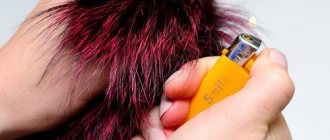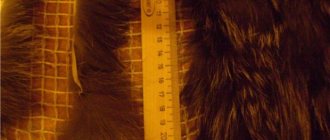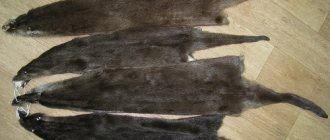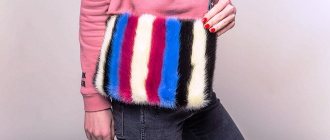Many women have a fur coat in their wardrobe, but in order for the item to please you for many years with its warmth and quality, you need to purchase properly made products. Quality is assessed according to two criteria - flesh and lint. The mezdra is the “skin part” of the fur coat, and the appearance and service life of the mink depend on its quality. They evaluate it by thickness, elasticity and color. If the skin is too dry, it will rustle like paper when crumpled. You can cope with this problem if you find out how to soften the flesh at home.
Mink white coat
It is easy to notice the dried skin on the inside of the hood; it has become rough to the touch, brittle and hard.
The characteristics of high-quality mink flesh are its sufficient elasticity (not to be confused with stretchiness), natural beige color, medium thickness and good strength.
mink flesh
Recipe 2
Another effective solution for softening at home:
- glucose – 20 g;
- salt (table) – 20 g;
- warm water – 1 liter;
- glycerin – 20 g;
- potassium alum – 15 g.
It is always possible to soften the flesh well with glycerin, but you can also use baby cream to improve the effect.
glycerol
Why stretch the skins?
If you decide to buy a fur coat, and the seller assures you that it is made from whole, unstretched skins, feel free to walk away - you are being blatantly deceived.
To make the product beautiful and of high quality, there is no other way than to stretch the core. Why? Imagine any animal - it is unlikely that in nature you will find such an individual whose head is the same size as its back. Therefore, any natural skin has the shape of a trapezoid, moreover, uneven at the edges. It is not possible to sew such skins together, much less make a fur product from them. In addition, untreated skin easily stretches in all directions, and even if you manage to sew a fur coat, then after the first wear in all “strategic” places: shoulders, elbows, on the chest and, excuse me, below the back, bubbles and stretch marks will remain, as in old "sweatpants". It is unlikely that anyone will like to wear such fur.
Recipe 4
You can soften mink flesh at home using the following composition:
- warm water – 1 liter;
- ammonia – 5-6 drops;
- toilet soap (preferably glycerin) and castor oil - 100 g each.
After the last procedure, the skin is folded with the fur facing out and left for 5 hours. Next, the product is dried in an unfolded form. It is advisable to leave the fur coat in a room with an air temperature no higher than 27°C.
It is important to understand that softening the flesh at home will not be possible quickly; the process takes a lot of time and is carried out in several stages. All ingredients are available, and the main part of them can be bought at the nearest pharmacy - this is glucose, ammonia, glycerin and castor oil. With their help, you can soften the skin of not only mink, but also arctic fox, black and brown fox and any other fur.
How to define quality?
Before you deal with the question of how to stretch the flesh, you need to find out what it is and why stretching is necessary.
The mezdra is the layer of subcutaneous tissue in the skin of an animal; it is, so to speak, the “leather part” of the fur coat. The service life of the product and its appearance will depend on the quality of its workmanship. The main evaluation parameters are the strength of the flesh, its thickness, color and elasticity, which depends on the amount of fat remaining after processing.
If the skin was too degreased during the preparation process, then when crumpled it will make a characteristic rustling sound, like parchment paper. This can be fixed, but you need to know how to soften the flesh. And if there is too much fat left, the leather part will look greasy and shiny; products made from such material run the risk of acquiring a sharp, characteristic smell of old lard over time.
High-quality leather has a tan leather fabric of a pleasant light beige color, is quite flexible and has a looser structure than suede.
Soft fur even after washing
You cannot wash fur items; you must use dry cleaning services. Cold water with powder will trigger the process of emulsification of fat; it will turn into a solution under the influence of the active substances included in the detergent. The fibers will become dry because they will lose their lubricant. This process is reversible.
Mink fur washed in hot water, that is, at temperatures above 40°C, cannot be restored. The protein in the fibers is destroyed, and it will not be possible to soften the core after washing again. Neither castor oil, nor glycerin, nor the services of professionals will help here.
Common damage
Oddly enough, people who are trying to figure out what “correct fur” looks like do it from a photograph. One of the so-called standards in this matter is mink flesh, photos of which can be found very often. However, it is very difficult to judge the quality from the image; for this you need to see the real color, smell, touch it with your hands, and listen to your feelings.
The most common defects are fur flow and stitching. The first, for example, is due to the fact that the hair follicles of some animals are not located in the flesh, but much deeper. After the skin has been removed, the hair loses its base and begins to fall off. If you pull the fur and a couple of hairs remain in your hands, do it again - as long as the “molting” stops the second or third time, everything is fine. Once you comb your fur coat thoroughly, the problem will disappear. But if each time you have more and more hairs in your hand, then the problem is quite serious, and it is called stitching. Here is the result of the work of a cross-haired fur master who cut off too much of the flesh along with the bulbs from which the hair grows.
After such shaving, the hairs simply have nothing to hold onto, and the fur falls off en masse. It is almost impossible to stop this process; we can safely say that the life of such a product is very short.
How to restore elasticity to mink?
You can soften fur after washing by soaking it well in a special solution with castor oil. To do this, you will need to take 40 g of butter, mix it well with raw egg yolk. Add 60 ml of water and 6 ml of ammonia to the resulting composition. Pass the mixture through a mixer until an emulsion is formed, similar in composition to milk. Rub the product into the base from the inside with a soft bristle brush.
To distribute the mixture evenly, the fur is well wrinkled and stretched in different directions. Drying is done at room temperature. If after this the flesh has not completely softened, castor oil, glycerin or baby cream is rubbed in, the excess of which is removed with dry sawdust. Fur can be saved provided that the protein is not destroyed after washing.
Leave your comment:
How to restore dry fur?
1. To restore the softness of somewhat coarsened fur, moisten its leather tissue with a solution containing a tablespoon of vinegar essence and 50 g of table salt per 1 liter of water, knead and gently pull in different directions. Repeat the operation several times with intervals of 2-3 hours, after which dry the fur and knead again. Good results are obtained by using a product that requires egg yolk, petroleum jelly and glycerin. Grind the yolk with 1 tablespoon of Vaseline, add 0.5 teaspoon of glycerin, mix everything and dilute with 0.5 liters of warm water. Wipe the leather of the fur with the resulting mixture, dry it, knead it and pull it. Sometimes it is possible to restore the softness and elasticity of fur by moistening the leather with glycerin diluted with water. Heavily soiled fur items are recommended to be dry cleaned. Simultaneously with the cleaning at the household service company, the item will be tinted or repainted in a different color at your request. 2. Remove greasy stains from hats, collars and other small fur items with a soft, clean rag soaked in gasoline. The fur is rubbed in one direction - along the long hair and against the short one. If the stain is old, add a pinch of lint-type washing powder to the gasoline. In this case, the fur is additionally wiped with clean gasoline. Stains from grease and sweat can be removed with a solution of ammonia and table salt in water (a teaspoon of alcohol and 3 tablespoons of salt per 0.5 liters of water) or a mixture of equal amounts of ammonia and denatured alcohol. Wipe the contaminated area with a rag soaked in liquid. 3. Large products made of light fur, if they are moderately soiled, are cleaned with rye or wheat bran. The bran is heated in a metal or clay vessel, stirring it with your hand until it tolerates. The hot bran is thoroughly but carefully wiped over the item piece by piece. - The most worn areas are treated 2-3 times. Having cleaned all the fur, the bran is brushed off and the item is beaten out with a twig or a thin stick. Instead of bran, you can use heated sawdust from deciduous (not coniferous, resinous!) wood. The sawdust should be sifted, preferably moistened with gasoline. — Colored astrakhan fur and white hare fur are also cleaned with oatmeal or rye flour. To clean the fur of a beaver, otter, or mole, dry sand is heated. The product sprinkled with sand is wiped with the palm of your hand, and the sand is replaced several times with new, clean sand. — It is good to clean white fur with potato flour or semolina. After sprinkling the fur with flour or cereal, you easily rub it with your hands, simulating washing. You can knead potato flour with gasoline, carefully rub the thick pulp into the fur against the hair and easily rub it along the hair. After shaking off the contaminated powder, carefully knock out the item. To completely clean the fur, 2-3 treatments may be required. — When trying to restore the whiteness of contaminated light-colored sheepskin, sprinkle the fur with potato flour and generously spray it with a warm solution of washing powder or soap from a spray bottle. Rub the pasty mass with your hands over the entire product and, when it dries, brush it off. It is possible that the desired effect will not be achieved on the first try. - Having finished cleaning the fur, removing the cleaning agent from it, knocking out and drying the item, in all cases, comb, straighten the tangled, stuck together hair, give it the desired direction. To increase shine, wipe the fur with a cloth moistened with glycerin, vinegar or a mixture of Vaseline and gasoline (1:5). 4. You can restore the shine of a tarnished fur item as follows. Grind the walnut kernels to a powder, tie the powder in gauze folded in two or three and rub the fur along the hair with this swab. After absorbing nut oil, the fur will acquire a beautiful, long-lasting shine.
To select fur skins, you can always write to me in private messages!
Types of fur and their characteristic features
Depending on the type of animal, fur is divided into:
- beaver fur (quite warm and moisture-resistant material);
- otter fur (one of the most wear-resistant);
- raccoon fur (warm and very popular fur, relatively inexpensive);
- marten fur (also warm, hypoallergenic and fairly wear-resistant material);
- ermine fur (very rare, expensive and not the most practical option);
- Karakul (expensive material with unusual colors);
- fox fur (beautiful and practical material);
- seal fur (easy to care for, suitable for very low temperatures);
- mink fur (beautiful, moisture-resistant, practical, rather expensive material: the cost of 1 meter of mink skin is more than 6,000 rubles).
This is not the entire range; there are other types of furs.
Two lines of defense
In fact, the skin is a double defensive line of the body. First of all, it is a physical barrier - after all, the skin separates the internal environment of the body from the external one due to the epidermis. In addition, the skin is an environment where a large number of microbes live (“skin pool”), which stimulate the immune system to produce immunoglobulins, antibodies, and specialize lymphocytes (which recognize a foreign antigen and kill it - killers).
If a person is not subjected to some kind of active “attack”, aggressive influence of external factors, then the mechanical function of the skin (external protection) becomes dominant. At this time, skin cells produce mainly substances that must support their own vital functions. In this state, the epithelium is populated by normal microflora and covered with the so-called fatty acid mantle. The cells of this layer of skin are tightly adherent to each other, so the barrier is quite effective in protecting against relatively large pathogens (for example, fungi or bacteria), but is often not reliable enough in the event of a viral infection.
If the skin is damaged, macrophages, leukocytes, lymphocytes and other cells accumulate at the site of damage, which produce immunoglobulin and antibodies. They bind and absorb damaged cells, transport and remove them, protecting the damaged area from the penetration of foreign agents.
When the skin is damaged, immune reactions are formed, but the skin is different in that it is the innate, nonspecific defense mechanisms that predominate in it.
How to repair a rip that runs along a seam
If the fur coat is slightly torn, then it can be repaired at home in two ways - sewn with thread or glued with a piece of fabric.
Sew with threads
If you have strong enough threads at home, then if you have the skill, you can carefully sew the hole. To do this you need:
- Open the lining from the wrong side of the product.
- Connect the edges of the torn fur coat tightly together.
- The seam must be made strong across the edge. First, pierce both edges of the fur coat, thread the thread through them, and then pierce again in the same direction at a short distance from the first.
It is important to make sure that the threads tightly tighten the edges of the fur coat so that it does not tear again in the future.
Glue
To glue the edges of the tear, you need to use special glue and cotton cloth. This must also be done from the wrong side:
- A piece of fabric is cut in such a way as to completely cover the gap.
- Next, glue is applied to the seam and fabric is applied.
- The edges are pressed against the fabric as tightly as possible to avoid small voids.
This trick cannot be performed in difficult areas, such as under the arms or on the sleeves, where the lines are not straight.
The product is torn near the sleeves or chest - what should I do?
The fur coat may tear on the chest due to the fact that the model is too narrow for you. In this case, you will also need to expand it with additional fur. If sleeves and armholes are torn, then several options are possible. First, peel back the lining and assess the damage. If the seam comes apart evenly, it can be easily corrected with a thick tailoring needle. In case of uneven tears, you will have to install a patch. If the fur “floated”, i.e. If the edges of the tear are torn and uneven, and the reason for this is that the narrow model is not suitable for you, then such a product will have to be altered. An alternative is to cut off the top of the fur coat and alter the product using the bottom. But keep in mind that in this case it will become much shorter. By the way, it is not recommended to perform such work on a typewriter - it is better to do it manually.
How to distinguish a fake?
There are often cases when natural fur is counterfeited with cheaper material. For example, after giving the appropriate appearance, a marten is passed off as a sable, a nutria is passed off as a beaver, and a mink is often replaced with a rabbit or marmot.
In order to recognize a substitution, you need to pay attention to the fur. The beaver, for example, has longer guard hairs than the nutria, and the undercoat is thicker. The spine of rabbit fur is much softer than that of mink. And the marmot's fur is of different lengths, unlike the mink, which has perfectly even hair.
What can cause a gap?
There are only a few reasons. They can be divided into separate categories:
- error in production;
- improper operation.
If the fur coat was initially produced incorrectly, for example, an error was made during dressing, storage or assembly, then it is not surprising that it tore. This option falls under the category of a warranty case. It is almost impossible to determine a defect when purchasing, so you won’t be able to protect yourself in advance.
If, after acquisition, the owner did not properly monitor and care for the product, violating the operating conditions, then it is not surprising that the fur coat tore under the sleeves, on the shoulders or collar.
How to make repairs if a fur coat is not torn along the seams
Quite often, a fur coat does not tear along the seams due to a puncture. Then the hole is small and easy to repair. For this you will also need to use glue and fabric.
To do everything as carefully as possible, you need to place the fur coat on a hard, flat surface. The following scheme is the same as described above. In the place where it tore, it is necessary to rip the lining. Level the area itself, apply glue and cloth and press firmly. But you should not seal hard-to-reach places or large areas in this way, for example, sleeves, under the arms or collar. On bends and moving parts, the glue will come off again in the future.
Fur processing - fatting
Fattening is necessary only if the elasticity of the skin is reduced, then work with fur begins. To eliminate dryness of the skin tissue after the drying stage, before removing the stretch, you should wipe the material with a cotton swab or a small piece of cloth soaked in glycerin. After this, leave the skin until the glycerin is completely absorbed, and only then remove it from the stretch. This procedure will prepare the skin for cutting, making it soft and elastic.
Then you can remove the material from the board, comb the fur and start cutting. Wavy edges should be straightened immediately.
What to do if your fur coat is torn due to a manufacturing defect
If the owner is fully confident that he maintained and wore the product in accordance with the required conditions, then he has the right to turn to the manufacturer for compensation. To do this, it will be necessary to conduct an independent examination, which will identify the defect and confirm that the fur coat was not negatively affected and was not torn because of the owner. This will establish a warranty case.
After this, the manufacturer will be obliged to pay compensation in the appropriate amount. However, this can result in a long and protracted process. Sometimes such cases end up in court.
Processing natural fur - stretching the material
Now it’s worth addressing the question of how to stretch the skin or process previously prepared fur. To do this, you need to moisten the skin. It is better to do this with a brush or spray bottle. Water quality plays an important role here. It is better if it is distilled, without various impurities of metals, chlorine and other elements.
After this procedure, the skin should lie for about 30 minutes. The exact curing time depends on the thickness and elasticity of the material. It is very important not to allow excess moisture - the fur must remain dry!
Stretching the skins can begin at the moment when the skin is almost dry. Editing should be done in the direction of the pile. The skin is straightened and pinned to the board with nails or safety pins. When stretching, try not to damage the structure of the skin and hair. If the pile is long, then such material is attached with the fur facing up, and if it is short or of medium length, then the fur is attached to the board.
The material should be stretched strictly in a certain sequence: first prick the bottom of the product, then the middle, then evenly stretch it to the left and right from the center and diagonally from the bottom up to the edges. After finishing stretching, leave the product to dry completely. On average, this time is about a day. Then remove the skin and leave it for at least 2 hours to cure. It should be noted here that the more the wet material is stretched, the more it will shrink. Having finished talking about how to stretch the skin, you can proceed to other processing methods.
Mink fur coat repair
Simple repairs that are quite accessible to every woman include the most common types of restoration, such as hooks and patches. This is the repair that does not change the main cut of the fur coat. This also includes updating fur that has lost its appearance.
More complex restorations include any change in style - or overall length of the product, or narrowing of the model.
But those types of repairs that it is better not to undertake with your own hands include global alteration of the model - sewing on the hood, narrowing or widening the armhole, widening the model to the bottom.
We will try to answer the most popular questions about repairs in a question-and-answer format.
What to do if the fur is worn out?
Most likely, you will have to put a patch in this place. To do this, you will have to purchase a skin of the same color as your fur coat (individual skins or even pieces of them can often be purchased from furriers). You can also use fur from a selection if the area of wear is small. When installing a patch, remember that the seam should always go from top to bottom, in the direction of the pile (photo).
Tanning hides
During the drying process and other procedures, the hide is subjected to mechanical processing, as a result of which the material becomes brittle and hard. Tanning helps strengthen the structure of the skin of mink, otter, raccoon, marten and other animals, which occurs due to the penetration of tanning substances into the skin, which bind protein fibers. After this procedure, the skin remains plastic and soft, and its resistance to decay and the influence of high temperatures increases. The material also withstands repeated exposure to water, painting and subsequent drying.
Tanning can be done either using chemicals or natural tanning agents of vegetable origin.
Let's consider one of the tanning methods. To do this, you will need a half-liter jar of oak bark, which can be purchased at the pharmacy. Fill it with two cans of water and bring to a boil, then boil for 10-15 minutes and leave to infuse for a day. Then the broth is filtered and applied cold with a brush to the skin from the inner side and dried on spacers. During the drying process, knead slightly.










